Icom IC-M34 User Manual
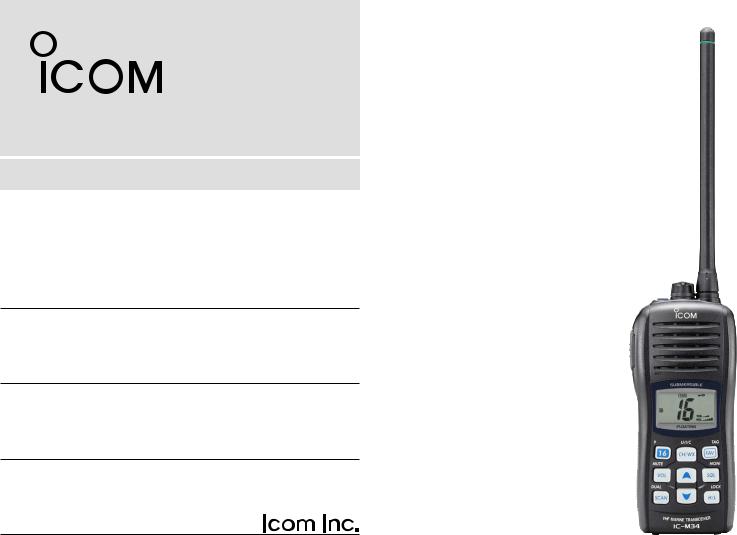
INSTRUCTION MANUAL
VHF MARINE TRANSCEIVER
iM34
This device complies with Part 15 of the FCC Rules. Operation is subject to the condition that this device does not cause harmful interference.
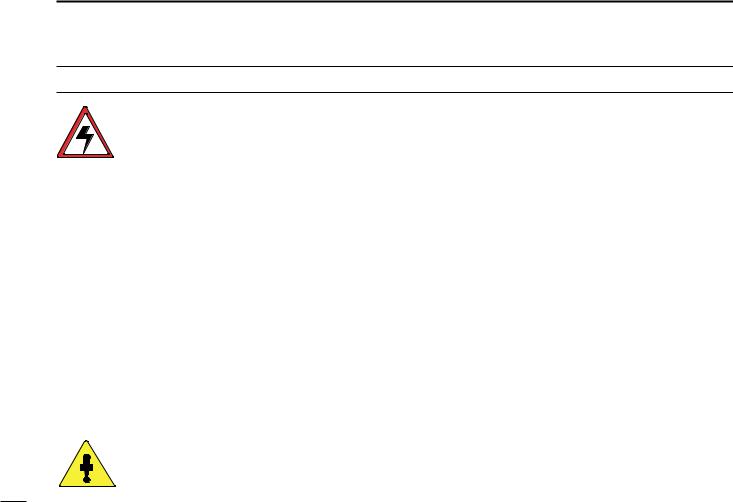
SAFETY TRAINING INFORMATION
Your Icom radio generates RF electromagnetic energy during transmit mode. This radio is designed for and classified as “Occupational Use Only”, meaning it must be used only during the course of employment by individuals aware of the haz-
W ARN ING
ards, and the ways to minimize such hazards. This radio is NOT intended for use by the “General Population” in an uncontrolled environment.
This radio has been evaluated for compliance at the distance of 2.5 cm with the FCC RF exposure limits for “Occupational Use Only”. In addition, your Icom radio complies with the following Standards and Guidelines with regard to RF energy and electromagnetic energy levels and evaluation of such levels for exposure to humans:
•FCC OET Bulletin 65 Edition 97-01 Supplement C, Evaluating Compliance with FCC Guidelines for Human Exposure to Radio Frequency Electromagnetic Fields.
•American National Standards Institute (C95.1-1992), IEEE Standard for Safety Levels with Respect to Human Exposure to Radio Frequency Electromagnetic Fields, 3 kHz to 300 GHz.
•American National Standards Institute (C95.3-1992), IEEE Recommended Practice for the Measurement of Potentially Hazardous Electromagnetic Fields– RF and Microwave.
•The following accessories are authorized for use with this product. Use of accessories other than those specified may result in RF exposure levels exceeding the FCC requirements for wireless RF exposure.; Belt Clip (MB109), Rechargeable Li-Ion Battery Pack (BP-252) and Alkaline Battery Case (BP-251).
To ensure that your expose to RF electromagnetic energy is within the FCC allowable limits for occupational use, always adhere to the following guidelines:
CAUTION
•DO NOT operate the radio without a proper antenna attached, as this may damaged the radio and may also cause you to exceed FCC RF exposure limits. A proper antenna is the antenna supplied with this radio by the manufacturer or antenna specifically authorized by the manufacturer for use with this radio.
•DO NOT transmit for more than 50% of total radio use time (“50% duty cycle”). Transmitting more than 50% of the time can cause FCC RF exposure compliance requirements to be exceeded. The radio is transmitting when the “TX indicator” lights red. You can cause the radio to transmit by pressing the “PTT” switch.
•ALWAYS keep the antenna at least 2.5 cm (1 inch) away from the body when transmitting and only use the Icom belt-clips which are listed on page 29 when attaching the radio to your belt, etc., to ensure FCC RF exposure compliance requirements are not exceeded. To provide the recipients of your transmission the best sound quality, hold the antenna at least 5 cm (2 inches) from your mouth, and slightly off to one side.
The information listed above provides the user with the information needed to make him or her aware of RF exposure, and what to do to assure that this radio operates with the FCC RF exposure limits of this radio.
Electromagnetic Interference/Compatibility
During transmissions, your Icom radio generates RF energy that can possibly cause interference with other devices or systems. To avoid such interference, turn off the radio in areas where signs are posted to do so. DO NOT operate the transmitter in areas that are sensitive to electromagnetic radiation such as hospitals, aircraft, and blasting sites.
Occupational/Controlled Use
The radio transmitter is used in situations in which persons are exposed as consequence of their employment provided those persons are fully aware of the potential for exposure and can exercise control over their exposure.
i
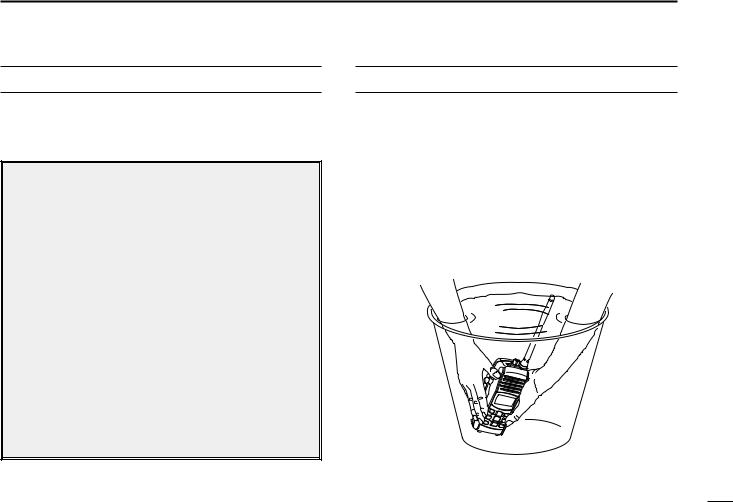
IN CASE OF EMERGENCY
If your vessel requires assistance, contact other vessels and the Coast Guard by sending a distress call on Channel 16.
USING CHANNEL 16
DISTRESS CALL PROCEDURE
1. |
“MAYDAY MAYDAY MAYDAY.” |
|
2. |
“THIS IS |
...........................” (name of vessel) |
3.Your call sign or other indication of the vessel.
4. “LOCATED AT ..................... |
” (your position) |
5.The nature of the distress and assistance required.
6.Any other information which might facilitate the rescue.
RECOMMENDATION
CLEAN THE TRANSCEIVER THOROUGHLY WITH FRESH WATER after exposure to saltwater, and dry it before operation. Otherwise, the transceiver's keys, switches and controllers may become unusable due to salt crystallization.
NOTE: DO NOT wash the transceiver in water if there is any reason to suspect the waterproofing may not be effective. For example, in cases where the battery pack rubber seal is damaged, the transceiver/battery pack is cracked or broken, or has been dropped, or when the battery pack is detached from the transceiver.
ii
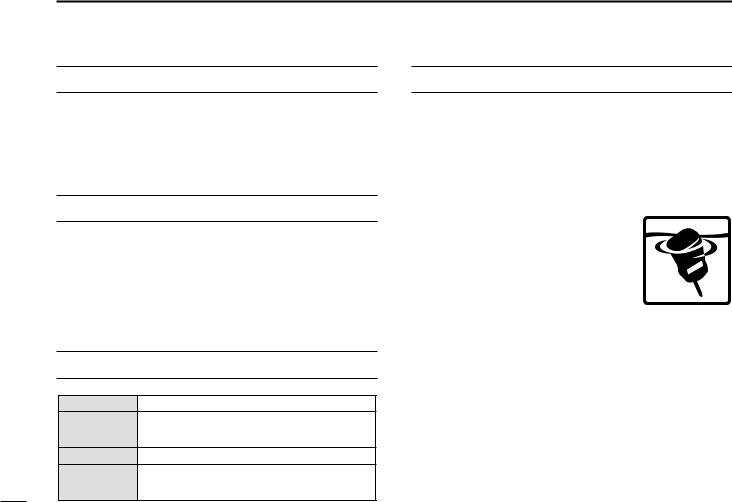
FOREWORD
Thank you for purchasing this Icom radio. The IC-M34 VHF MA- RINE TRANSCEIVER is designed and built with Icom’s state of the art technology and craftsmanship. With proper care this radio should provide you with years of trouble-free operation.
IMPORTANT
READ ALL INSTRUCTIONS carefully and com-
pletely before using the transceiver.
SAVE THIS INSTRUCTION MANUAL—This in-
struction manual contains important operating instructions for the IC-M34.
EXPLICIT DEFINITIONS
WORD |
DEFINITION |
Personal injury, fire hazard or electric shock RWARNING may occur.
CAUTION Equipment damage may occur.
NOTE
If disregarded, inconvenience only. No risk of personal injury, fire or electric shock.
iii
FEATURES
Submersible construction
Built tough to withstand the punishing marine environment, the IC-M34’s submersible construction meets IPX7 of the corresponding International Standard IEC 60529 (2001) while using BP-251 (option) or BP-252.
Floating on water
The IC-M34 floats on fresh or salt water even when the supplied accessories are attached.
•When third-party battery pack, strap, antenna, etc. is used, it may sink.
•The battery contacts may be prone to rusting if the transceiver is kept floating in fresh or salt water.
Large, easy-to-read LCD
With dimensions of 16(H) × 32(W) mm; 5⁄8(H) × 11⁄4(W) inch, the IC-M34’s function display is easy to read and shows operating conditions at a glance. Backlighting and contrast can be adjusted to suit your preferences.
Simple operation
9 large buttons on the front panel provide user-friendly operation. The independent volume and channel buttons are located on the front panel for convenient one-hand operation.
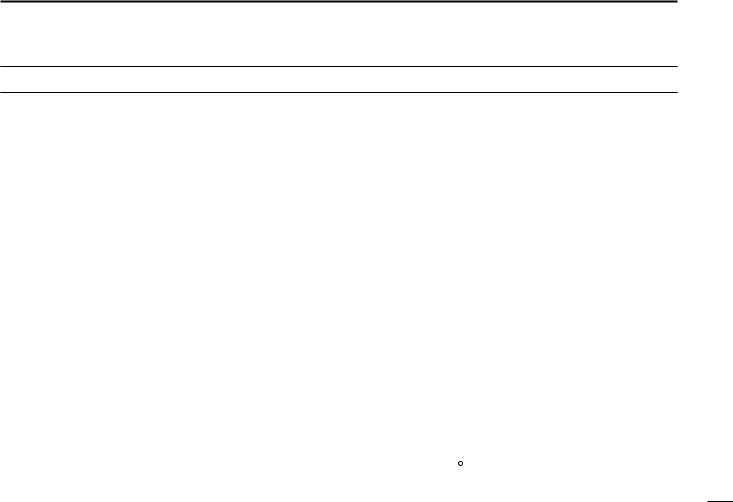
PRECAUTIONS
RWARNING! NEVER connect the transceiver to an AC outlet. This may pose a fire hazard or result in an electric shock.
RWARNING! NEVER hold the transceiver so that the antenna is closer than 2.5 cm (1 inch) from exposed parts of the body, especially the face or eyes, while transmitting. The transceiver will perform best if the microphone is 5 to 10 cm (2 to 4 inches) away from the lips and the transceiver is vertical.
NEVER connect the transceiver to a power source other than the BP-251 (option) or BP-252. Such a connection will ruin the transceiver.
AVOID using or placing the transceiver in direct sunlight or in areas with temperatures below –20°C (–4°F) or above +60°C (+140°F).
KEEP the transceiver out of the reach of children.
KEEP the transceiver at least 0.9 meters (3.0 ft) away from your vessel’s magnetic navigation compass.
BE CAREFUL! The transceiver’s right-side panel will become hot when operating continuously for long periods.
BE CAREFUL! The transceiver employs waterproof construction, which corresponds to IPX7 of the international standard IEC 60529 (2001). However, once the transceiver has been dropped, waterproofing cannot be guaranteed due to the fact that the transceiver may be cracked, or the waterproof seal damaged, etc.
MAKE SURE the flexible antenna and battery pack are securely attached to the transceiver, and that the antenna and battery pack are dry before attachment. Exposing the inside of the transceiver to water will result in serious damage to the transceiver.
After exposure to water, clean the battery contacts thoroughly with fresh water and dry them completely to remove any water or salt residue.
For U.S.A. only
CAUTION: Changes or modifications to this device, not expressly approved by Icom Inc., could void your authority to operate this device under FCC regulations.
Icom, Icom Inc. and the 
 logo are registered trademarks of Icom Incorporated (Japan) in the United States, the United Kingdom, Germany, France, Spain, Russia and/or other countries.
logo are registered trademarks of Icom Incorporated (Japan) in the United States, the United Kingdom, Germany, France, Spain, Russia and/or other countries.
iv

TABLE OF CONTENTS
SAFETY TRAINING INFORMATION ......................................... |
i |
|
IN CASE OF EMERGENCY ..................................................... |
ii |
|
RECOMMENDATION ............................................................... |
ii |
|
FOREWORD ............................................................................ |
iii |
|
IMPORTANT ............................................................................ |
iii |
|
EXPLICIT DEFINITIONS .......................................................... |
iii |
|
FEATURES .............................................................................. |
iii |
|
PRECAUTIONS ....................................................................... |
iv |
|
TABLE OF CONTENTS ............................................................ |
v |
|
1 |
OPERATING RULES ......................................................... |
1 |
2 SUPPLIED ACCESSORIES AND ATTACHMENTS ....... |
2–3 |
|
|
■ Supplied accessories ....................................................... |
2 |
|
■ Attachments ..................................................................... |
2 |
3 |
PANEL DESCRIPTION .................................................. |
4–7 |
|
■ Front, top and side panels ............................................... |
4 |
|
■ Function display .............................................................. |
6 |
4 |
BASIC OPERATION .................................................... |
8–13 |
|
■ Channel selection ........................................................... |
8 |
|
■ Receiving and transmitting ............................................ |
10 |
|
■ Call channel programming ............................................ |
11 |
|
■ Adjusting the volume level ............................................. |
11 |
|
■ Volume mute function .................................................... |
11 |
|
■ Adjusting the squelch level ........................................... |
12 |
|
■ Lock function ................................................................. |
12 |
|
■ Automatic backlighting .................................................. |
12 |
|
■ Monitor function ............................................................ |
13 |
|
■ AquaQuake water draining function .............................. |
13 |
5 |
SCAN OPERATION ................................................... |
14–15 |
|
■ Scan types .................................................................... |
14 |
|
■ Setting TAG channels ................................................... |
15 |
|
■ Starting a scan .............................................................. |
15 |
6 |
DUALWATCH/TRI-WATCH .............................................. |
16 |
|
■ Description .................................................................... |
16 |
|
■ Operation ...................................................................... |
16 |
7 |
SET MODE ................................................................. |
17–20 |
|
■ Set mode programming ................................................ |
17 |
|
■ Set mode items ............................................................. |
18 |
8 |
BATTERY CHARGING ............................................... |
21–24 |
|
■ Battery caution .............................................................. |
21 |
|
■ Supplied battery charger ............................................... |
23 |
|
■ Optional battery case ..................................................... |
23 |
|
■ Optional battery charger ............................................... |
24 |
9 |
OPTIONAL SPEAKER-MICROPHONE ........................... |
25 |
|
■ HM-165 descriptions ..................................................... |
25 |
|
■ Attachment .................................................................... |
25 |
10 |
TROUBLESHOOTING ..................................................... |
26 |
11 |
VHF MARINE CHANNEL LIST ........................................ |
27 |
12 |
SPECIFICATIONS............................................................. |
28 |
13 |
OPTIONS .......................................................................... |
29 |
v

D Priorities
•Read all rules and regulations pertaining to priorities and keep an up-to-date copy handy. Safety and distress calls take priority over all others.
•You must monitor Channel 16 when you are not operating on another channel.
•False or fraudulent distress calls are prohibited under law.
D Privacy
•Information overheard but not intended for you cannot lawfully be used in any way.
•Indecent or profane language is prohibited.
D Radio licenses
(1) SHIP STATION LICENSE
When your craft is equipped with a VHF FM transceiver, you must have a current radio station license before using the transceiver. It is unlawful to operate a ship station which is not licensed.
Inquire through your dealer or the appropriate government agency for a Ship-Radiotelephone license. This license includes the call sign which is your craft’s identification for radio purposes.
OPERATING RULES |
1 |
|
|
|
|
|
|||
|
|
|||
|
|
|||
(2) OPERATOR’S LICENSE |
|
|
|
|
|
|
1 |
||
A restricted Radiotelephone Operator Permit is the license |
||||
|
||||
most often held by small vessel radio operators when a radio |
||||
is not required for safety purposes. |
|
|
|
|
The Restricted Radiotelephone Operator Permit must be posted near the transceiver or be kept with the operator. Only a licensed radio operator may operate a transceiver.
However, non-licensed individuals may talk over a transceiver if a licensed operator starts, supervises, ends the call and makes the necessary log entries.
A current copy of the applicable government rules and regulations is only required to be on hand for vessels in which a radio telephone is compulsory. However, even if you are not required to have these on hand it is your responsibility to be thoroughly acquainted with all pertinent rules and regulations.
NOTE: Even though the IC-M34 is capable of operation on VHF marine channels 3, 21, 23, 61, 64, 81, 82 and 83, according to FCC regulations these simplex channels cannot be lawfully used by the general population in U.S.A. waters.
1
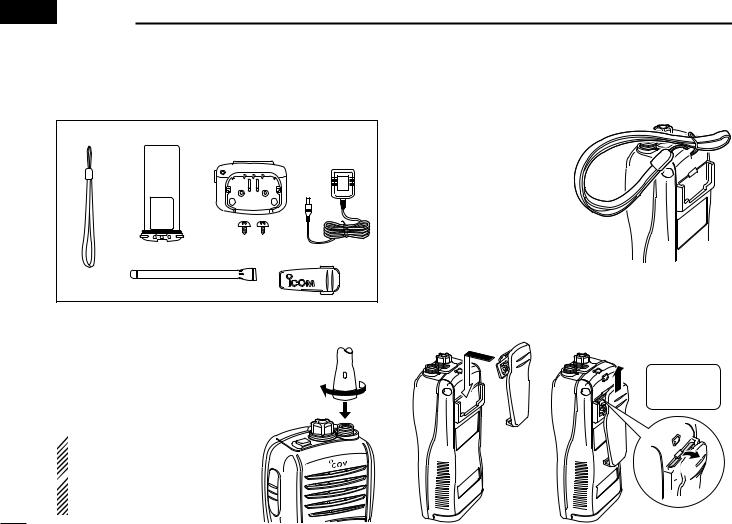
 2 SUPPLIED ACCESSORIES AND ATTACHMENTS
2 SUPPLIED ACCESSORIES AND ATTACHMENTS
■ Supplied accessories
Handstrap |
Battery pack |
Battery charger |
AC adapter |
|
|
(with 2 screws) |
(Depending |
|
|
|
on version) |
Antenna |
Belt clip |
■ Attachments
D Flexible antenna
Connect the supplied flexible antenna to the antenna connector.
 CAUTION!
CAUTION!
• NEVER carry the transceiver
by the antenna.
 • Transmitting without an an-
• Transmitting without an an-
tenna may damage the transceiver.
D Handstrap
Pass the handstrap through the loop on the side of the transceiver as illustrated at right. This facilitates carrying.
D Belt clip
Attach/detach the belt clip to the transceiver as illustrated below.
To attach the belt clip |
To detach the belt clip |
|
w Be careful! |
|
Not to break |
|
your nails. |
 q
q
2
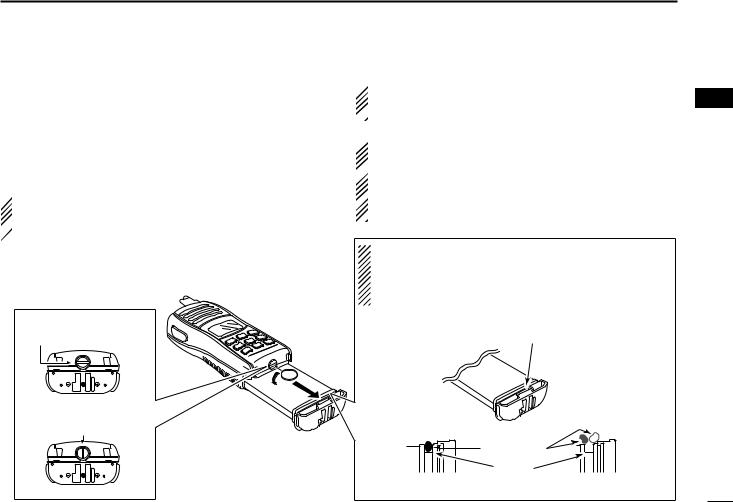
SUPPLIED ACCESSORIES AND ATTACHMENTS 2
ï Battery pack
To remove the battery pack:
Turn the screw counterclockwise one quarter turn, then pull the battery pack in the direction of the arrow as shown below.
To attach the battery pack:
Insert the battery pack in the IC-M34 completely, then turn the screw clockwise one quarter turn.
 NEVER remove or insert the battery pack when the trans-
NEVER remove or insert the battery pack when the trans-
ceiver is wet or soiled. This may result water or dust get-
 ting into the transceiver/battery pack and may result in the
ting into the transceiver/battery pack and may result in the  transceiver being damaged.
transceiver being damaged.
Screw position
when removing battery
Screw position
when attaching battery
 NOTE: When removing or attaching the battery pack, use
NOTE: When removing or attaching the battery pack, use
a coin or standard screwdriver to loosen or tighten the bot- 2  tom screw.
tom screw.
 CAUTION!:
CAUTION!:
When attaching or removing a battery pack, make sure the
 rubber seal is set in the groove of the battery pack cor-
rubber seal is set in the groove of the battery pack cor-
rectly. If the seal is not neatly in the groove it may be dam-
 aged when attaching the battery pack.
aged when attaching the battery pack.
 If the seal is damaged, waterproofing is not guaranteed.
If the seal is damaged, waterproofing is not guaranteed.
NOTE:
When attaching a battery pack, make sure dust or other material does not adhere to the rubber seal. If dust or other material is on the seal when attaching a battery pack, water resistance may be compromised.
Make sure the rubber seal (purple) is properly seated in the groove and dust or other material does not adhere to it.
Correct position |
Incorrect position |
|
Rubber seal |
|
Groove |
Battery pack |
Battery pack |
3
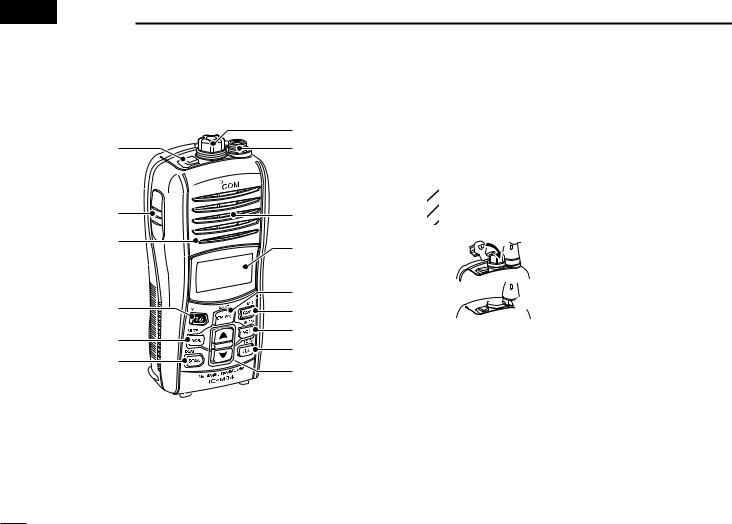
 3 PANEL DESCRIPTION
3 PANEL DESCRIPTION
■ Front, top and side panels
|
w |
q |
e |
!2 |
Speaker |
Microphone
Function display (pgs. 6, 7)
|
r |
!1 |
t |
|
y |
!0 |
u |
|
o |
||
i |
||
|
qPOWER SWITCH [PWR]
Push and hold to turn power ON and OFF.
wSPEAKER-MICROPHONE CONNECTOR [SP MIC] (p. 25) Connects the optional external speaker-microphone.
 NOTE: Attach the [SP MIC] cap when the optional
NOTE: Attach the [SP MIC] cap when the optional
 speaker-microphone is not used. Otherwise, water will
speaker-microphone is not used. Otherwise, water will
 get into the transceiver.
get into the transceiver.
q Attach the [SP MIC] cap.
 w Then rotate it clockwise
w Then rotate it clockwise  w completely.
w completely.
eANTENNA CONNECTOR (p. 2) Connects the supplied antenna.
rCHANNEL/WEATHER CHANNEL KEY [CH/WX•U/I/C]
Toggles between the regular channel and weather channel when pushed. (p. 9)
Selects the U.S.A., International or Canadian channel group when pushed and held for 1 sec. (p. 9)
Push to return to the previous channel before selecting channel 16 or the call channel.
4

PANEL DESCRIPTION 3
tFAVORITE/TAG KEY [FAV•TAG]
While pushing and holding this key, push [Y]/[Z] to select the favorite (TAG) channels with ignoring untagged channels in the selected channel group in sequence. (p. 8)
• Pushing this key only advances the displayed TAG channel.
Push and hold for 1 sec. to set or clear the displayed channel as a TAG (scanned) channel. (p. 15)
While pushing and holding this key, turn power ON to clear or set all TAG channels (when no TAG channel has been set) in the selected channel group. (p. 15)
ySQUELCH/MONITOR KEY [SQL•MONI]
Push this key, then adjust the squelch level with [Y]/[Z]. (p. 12)
Manually opens the squelch for monitoring the channel while pushing and holding. (p. 13)
While pushing and holding this key, turn power ON to enter the set mode. (p. 17)
uTRANSMIT POWER/LOCK KEY [H/L•LOCK]
Selects high or low power when pushed. (p. 10)
Toggles between the key lock function ON/OFF when pushed and held for 1 sec. (p. 12)
iCHANNEL UP/DOWN KEYS [Y]/[Z]
Selects an operating channel. (pgs. 8, 9)
Selects the set mode setting of the item. (p. 17)
Checks TAG channels or changes scanning direction during scan. (p. 15)
o SCAN/DUAL KEY [SCAN•DUAL] |
|
Push to start or stop normal or priority scan. (p. 15) |
3 |
Push and hold for 1 sec. to enter watch mode. (p. 16)
Push and hold this key and [H/L], to activate the AquaQuake function. (p. 13)
Exits watch mode when pushed during watch operation. (p. 16)
!0VOLUME KEY [VOL•MUTE]
Push this key, then adjust the volume level with [Y]/[Z]. (p. 11)
Push and hold for 1 sec. to activate the volume mute function. (p. 11)
!1CHANNEL 16 KEY [16•9]
Push to select Channel 16. (p. 8)
Push and hold for 1 sec. to select the call channel. (p. 8)
Enters call channel programming condition when the call channel is selected and this key is pushed and held for 3 sec. (p. 11)
Push to exit set mode during set mode operation. (p. 17)
!2PTT SWITCH [PTT]
Push and hold to transmit; release to receive. (p. 10)
5
